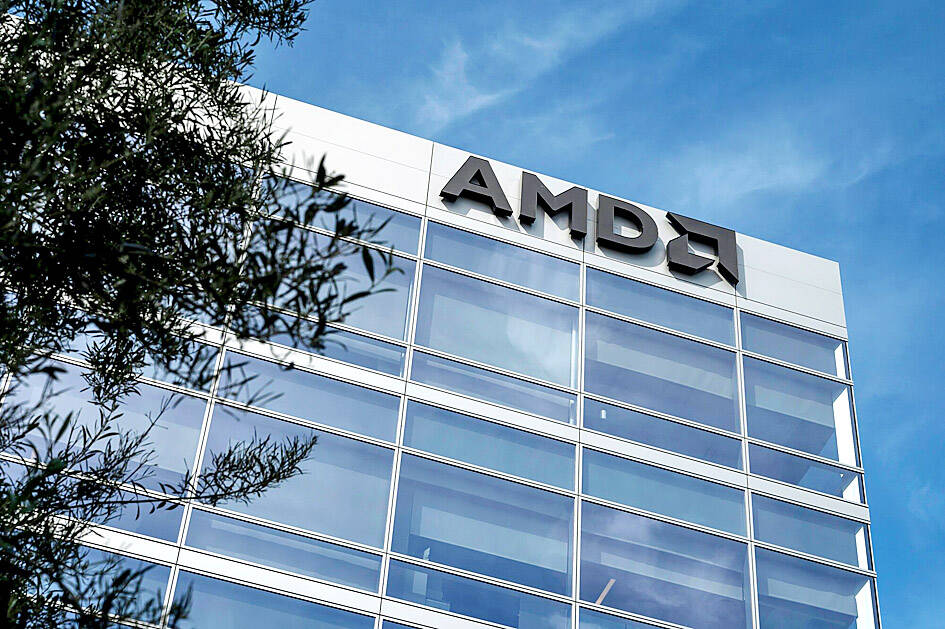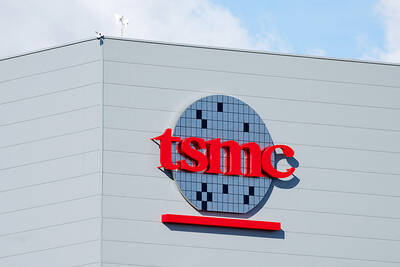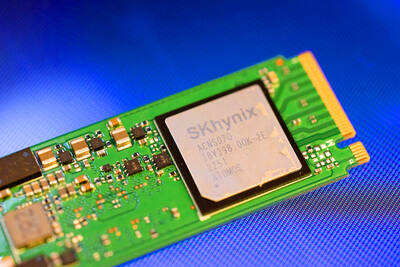Advanced Micro Devices Inc (AMD), the second-biggest maker of computer processors, on Tuesday gave a lukewarm revenue forecast for the current period, weighed down by lackluster demand for chips used in video game hardware.
Second-quarter revenue would be approximately US$5.7 billion, the company said in a statement.
That compares with an average analyst estimate of US$5.72 billion.

Photo: Bloomberg
AMD said that its gross margin would be about 53 percent in the second quarter, matching predictions.
Revenue from AMD’s gaming division fell well short of projections in the first quarter, but the company is expecting to get a boost from a push into artificial intelligence (AI) accelerators — Nvidia Corp-style chips that help develop chatbots and other AI tools.
The company has projected that its new MI300 products would generate as much as US$3.5 billion of revenue this year.
“This is an incredibly exciting time for the industry as widespread deployment of AI is driving demand for significantly more compute across a broad range of markets,” AMD chief executive officer Lisa Su (蘇姿丰) said in the statement.
The AMD report follows a downbeat forecast last week from Intel Corp, which said it expects demand to remain sluggish in the first half of the year, but AMD is still expecting growth in the range of 6 percent in the current quarter, better than the roughly flat projection of its larger rival.
First-quarter earnings per share were US$0.62, excluding some items, on revenue of US$5.47 billion. That performance compared with estimated earnings per share of US$0.61 and US$5.45 billion in sales.
AMD’s PC chip division had revenue of about US$1.4 billion, compared with a US$1.29 billion estimate.
Data center sales came in at US$2.3 billion, in line with the average projection.
Meanwhile, gaming computer-related revenue was US$922 million. Analysts had expected sales of US$965.5 million.
Like Intel, AMD still gets most of its revenue from PC and server microprocessors. The once-solid server market has been less reliable because operators of data centers have plowed much of their budgets into Nvidia chips — the very area AMD is now making its own play for.
AMD also competes with Nvidia in the market for graphics processors that improve the images in video games. It is the biggest rival of Intel in both server and PC processors — as well as in programmable logic chips, which can be reconfigured with software after they are installed, and it supplies Microsoft Corp and Sony Group Corp with the main component in their game consoles.
Separately, Super Micro Computer Inc also on Tuesday reported quarterly sales that fell slightly short of estimates. The results disappointed investors who had sky-high expectations that the server maker’s business would benefit from AI-related demand.
Revenue in the March quarter climbed to US$3.85 billion, the company said in a statement. That’s just below the consensus estimate of US$3.86 billion, according to data compiled by Bloomberg. Profit, excluding some items, was US$6.65 per share, ahead of the US$5.58 expected by Wall Street analysts.
A jump in demand for the equipment that powers artificial intelligence training and applications has helped drive sales at Super Micro, which makes data center servers. Growth rates at the San Jose, California-based company have climbed higher in recent quarters on the back of deals with large corporations and an improving supply of high-powered chips.
Chief executive officer Charles Liang (梁見後) said in a statement that the company should “continue gaining market share” as new products are released.
Revenue in the quarter ending in June will be US$5.1 billion to US$5.5 billion, the company said. Analysts, on average, projected US$4.73 billion, according to data compiled by Bloomberg. Profit, excluding some items, will be as much as US$8.42 per share, compared with an average estimate of US$6.97.

Taiwan Semiconductor Manufacturing Co (TSMC, 台積電) secured a record 70.2 percent share of the global foundry business in the second quarter, up from 67.6 percent the previous quarter, and continued widening its lead over second-placed Samsung Electronics Co, TrendForce Corp (集邦科技) said on Monday. TSMC posted US$30.24 billion in sales in the April-to-June period, up 18.5 percent from the previous quarter, driven by major smartphone customers entering their ramp-up cycle and robust demand for artificial intelligence chips, laptops and PCs, which boosted wafer shipments and average selling prices, TrendForce said in a report. Samsung’s sales also grew in the second quarter, up

LIMITED IMPACT: Investor confidence was likely sustained by its relatively small exposure to the Chinese market, as only less advanced chips are made in Nanjing Taiwan Semiconductor Manufacturing Co (TSMC, 台積電) saw its stock price close steady yesterday in a sign that the loss of the validated end user (VEU) status for its Nanjing, China, fab should have a mild impact on the world’s biggest contract chipmaker financially and technologically. Media reports about the waiver loss sent TSMC down 1.29 percent during the early trading session yesterday, but the stock soon regained strength and ended at NT$1,160, unchanged from Tuesday. Investors’ confidence in TSMC was likely built on its relatively small exposure to the Chinese market, as Chinese customers contributed about 9 percent to TSMC’s revenue last

LOOPHOLES: The move is to end a break that was aiding foreign producers without any similar benefit for US manufacturers, the US Department of Commerce said US President Donald Trump’s administration would make it harder for Samsung Electronics Co and SK Hynix Inc to ship critical equipment to their chipmaking operations in China, dealing a potential blow to the companies’ production in the world’s largest semiconductor market. The US Department of Commerce in a notice published on Friday said that it was revoking waivers for Samsung and SK Hynix to use US technologies in their Chinese operations. The companies had been operating in China under regulations that allow them to import chipmaking equipment without applying for a new license each time. The move would revise what is known

UNCERTAINTY: A final ruling against the president’s tariffs would upend his trade deals and force the government to content with billions of dollars in refunds The legal fight over US President Donald Trump’s global tariffs is deepening after a federal appeals court ruled the levies were issued illegally under an emergency law, extending the chaos in global trade. A 7-4 decision by a panel of judges on Friday was a major setback for Trump, even as it gives both sides something to boast about. The majority upheld a May ruling by the Court of International Trade that the tariffs were illegal. However, the judges left the levies intact while the case proceeds, as Trump had requested, and suggested that any injunction could potentially be narrowed to apply